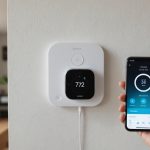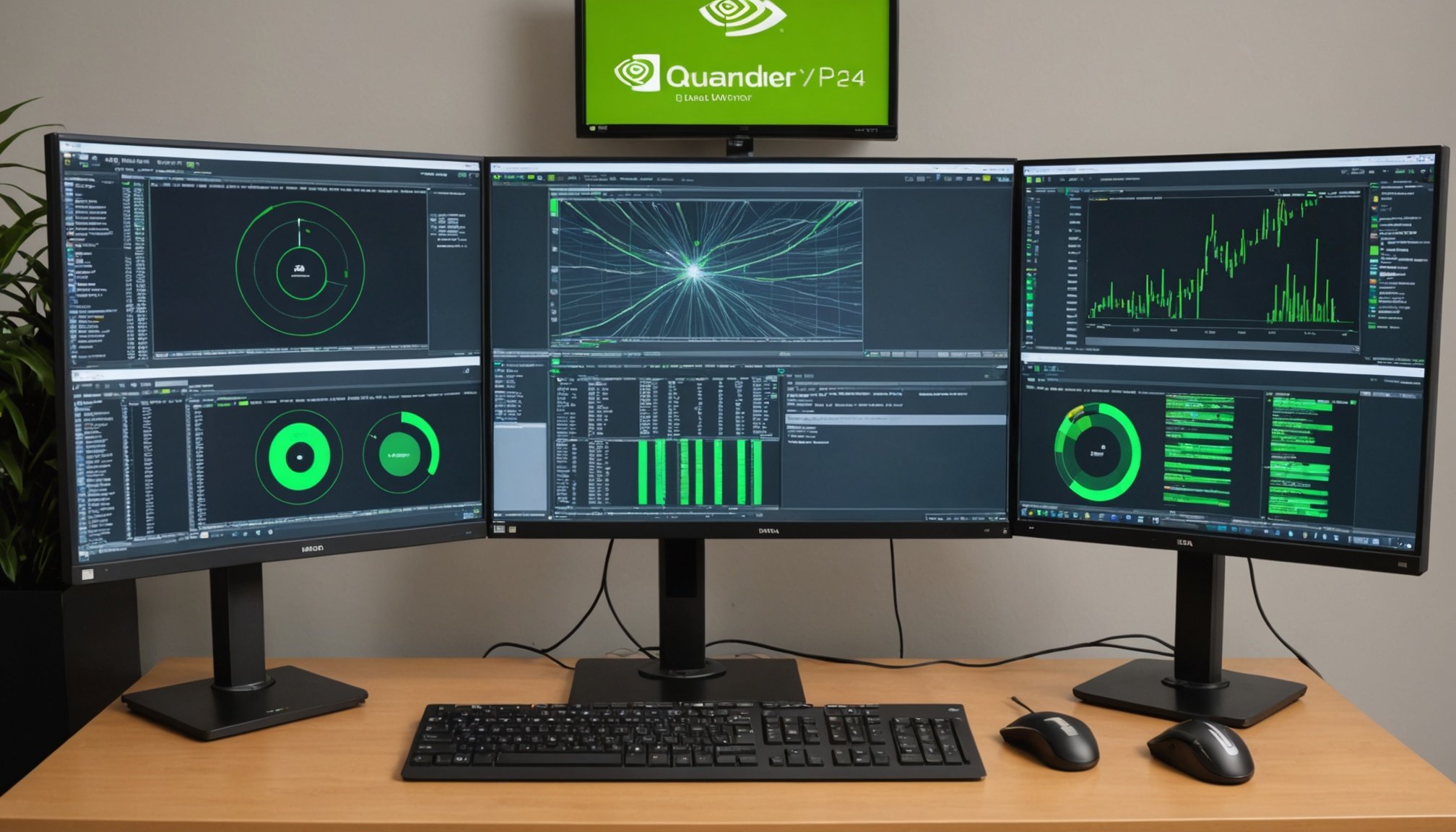Unlocking Your Trading Potential: A Comprehensive Guide to Setting Up a High-Resolution Multi-Monitor Display with the NVIDIA Quadro P2000
Understanding the NVIDIA Quadro P2000
When it comes to setting up a high-performance trading station, the graphics card is one of the most critical components. The NVIDIA Quadro P2000 is a mid-range workstation graphics card designed specifically for professional applications, including trading, CAD, DCC, medical imaging, and more. Here’s why it stands out:
Certified Drivers and Performance
The Quadro P2000 is based on the GP107 chip, featuring 768 unified shaders and a memory bus width of 128 bits with GDDR5 memory. What sets it apart from consumer-grade GPUs like the GeForce GTX 1050 is its certified drivers, optimized for stability and performance in professional applications. This ensures that the Quadro P2000 delivers much better performance in these areas compared to its consumer counterparts[1].
In the same genre : Mastering overclocking: the complete guide to enhancing performance on your asus rog crosshair viii hero with liquid cooling
Key Features
- Architecture: The Quadro P2000 uses the Pascal architecture, which includes features like DisplayPort 1.4, HDMI 2.0b, HDR, Simultaneous Multi-Projection (SMP), and improved H.265 video de- and encoding.
- Power Consumption: With a power consumption ranging between 60 and 70 watts, it is energy-efficient without compromising on performance.
- Memory and Speed: It supports up to 4 GB of GDDR5 memory with a memory speed of 6008 MHz, making it suitable for demanding multi-monitor setups.
Setting Up Your Multi-Monitor Display
Setting up a high-resolution multi-monitor display is more than just plugging in a few monitors. Here’s a step-by-step guide to help you get started:
Choosing the Right Monitors
When selecting monitors for your trading setup, consider the following factors:
Also to read : Maximize your lenovo thinkpad x1 carbon for effortless remote work with dual monitor setup
- Resolution: High-resolution monitors (such as 4K or QHD) provide clearer and more detailed displays, which are crucial for analyzing financial data.
- Refresh Rate: A higher refresh rate (e.g., 144Hz or 240Hz) can enhance the smoothness of the display, especially if you are using real-time data feeds.
- Connectivity: Ensure the monitors have the right connectivity options (e.g., DisplayPort, HDMI, USB-C) to match your GPU.
Configuring Your GPU
The NVIDIA Quadro P2000 supports multiple display outputs, including DisplayPort 1.4 and HDMI 2.0b. Here’s how to configure it:
- Display Outputs: The Quadro P2000 can support up to four displays simultaneously. Use the NVIDIA Control Panel to configure the display settings and ensure each monitor is recognized and set up correctly.
- Resolution and Refresh Rate: Adjust the resolution and refresh rate settings for each monitor to optimize performance and visual quality.
Example Configuration
Here’s an example of how you might set up your multi-monitor display:
| Monitor | Resolution | Refresh Rate | Connection |
|---|---|---|---|
| Monitor 1 | 3840 x 2160 (4K) | 60Hz | DisplayPort 1.4 |
| Monitor 2 | 2560 x 1440 (QHD) | 144Hz | HDMI 2.0b |
| Monitor 3 | 2560 x 1440 (QHD) | 144Hz | DisplayPort 1.4 |
| Monitor 4 | 1920 x 1080 (FHD) | 60Hz | HDMI 2.0b |
Optimizing Performance for Trading
To get the most out of your NVIDIA Quadro P2000 and multi-monitor setup for trading, consider the following optimizations:
Software Configuration
- NVIDIA Control Panel: Use the NVIDIA Control Panel to adjust settings such as anti-aliasing, texture filtering, and more to balance performance and visual quality.
- Trading Software: Ensure your trading software is optimized for multi-monitor setups. Many trading platforms, such as MetaTrader or TradingView, offer features to take full advantage of multiple screens.
Hardware Considerations
- Processors and Memory: While the GPU is crucial, having a powerful processor (such as Intel Xeon) and ample memory (e.g., up to 24 DIMM sockets in servers like Lenovo ThinkSystem SR630) can significantly enhance overall system performance[2][3].
- Network and Storage: A fast network interface (e.g., Gigabit Ethernet) and high-speed storage (e.g., SSDs) can reduce data latency and improve the overall trading experience.
Cost-Effective Solutions
Setting up a high-performance trading station doesn’t have to break the bank. Here are some cost-effective solutions to consider:
Choosing the Right GPU
While the NVIDIA Quadro P2000 is a powerful option, it may not be the only choice. Here’s a comparison with other GPUs:
| GPU | Architecture | Pipelines | Memory | Price Range |
|---|---|---|---|---|
| NVIDIA Quadro P2000 | Pascal | 768 | 4 GB GDDR5 | $400-$600 |
| NVIDIA GeForce GTX 1050 | Pascal | 640 | 2 GB GDDR5 | $200-$400 |
| NVIDIA GeForce GTX 1060 Max-Q | Pascal | 1280 | 6 GB GDDR5 | $300-$500 |
Monitors and Accessories
- Monitors: Look for monitors with good reviews and features that fit your budget. Brands like Dell, ASUS, and BenQ offer a range of options.
- Cables and Adapters: Ensure you have the right cables and adapters to connect all your monitors. DisplayPort splitters or adapters can be cost-effective solutions.
Practical Insights and Actionable Advice
Here are some practical tips to help you set up and optimize your trading station:
Monitor Placement
- Place your primary monitor directly in front of you, with secondary monitors angled to reduce eye strain.
- Use monitor arms to adjust the height and position of each screen for optimal comfort.
Ergonomics
- Invest in an ergonomic chair and desk to ensure long hours of trading are comfortable.
- Use a keyboard tray and mouse pad to maintain good posture.
Software Tips
- Use the NVIDIA Control Panel to set up custom profiles for different trading scenarios.
- Take advantage of multi-monitor features in your trading software to spread charts, news feeds, and other data across multiple screens.
Real-World Examples and Anecdotes
Many traders have seen significant improvements in their trading performance after setting up a multi-monitor display with a high-performance GPU like the NVIDIA Quadro P2000.
Case Study: John, a Day Trader
John, a day trader from the United States, switched from a single monitor setup to a four-monitor setup using the NVIDIA Quadro P2000. He reported a significant reduction in eye strain and an improvement in his ability to analyze multiple charts and data feeds simultaneously. Here’s what John had to say:
“Since I upgraded to the Quadro P2000 and a multi-monitor setup, my trading has become much more efficient. I can now keep an eye on multiple charts, news feeds, and my trading platform all at once, which has really improved my decision-making.”
Setting up a high-resolution multi-monitor display with the NVIDIA Quadro P2000 is a powerful way to enhance your trading potential. By understanding the capabilities of the Quadro P2000, configuring your setup correctly, and optimizing performance, you can create a trading station that is both efficient and cost-effective.
Key Takeaways
- GPU Selection: Choose a GPU that supports multiple high-resolution monitors, such as the NVIDIA Quadro P2000.
- Monitor Configuration: Ensure your monitors are connected and configured correctly using the NVIDIA Control Panel.
- System Optimization: Optimize your system with powerful processors, ample memory, and fast network and storage solutions.
- Ergonomics and Software: Pay attention to ergonomics and use software features to maximize the benefits of your multi-monitor setup.
By following these steps and tips, you can unlock your full trading potential and take your trading to the next level.











